By Rick VanSickle
The birth of the Canadian wine industry was a chaotic time, and the man who was at the centre of it all is still at it 50 years later.
And it took a weather catastrophe this past winter in B.C. wine country to reawaken that passion in Donald Ziraldo, who in 1975, received the first new winery licence in almost 50 years along with his late partner Karl Kaiser of Inniskillin Estate Winery in Niagara-on-the-Lake. That licence proved to be the catalyst for kick-starting the modern wine industry in this country. Up until that point, Ontario was planted to a sea of labrusca grapes; hybrids that fuelled an array of rather pedestrian (being kind here) wines made in industrial factories by a scant few mega wine companies.
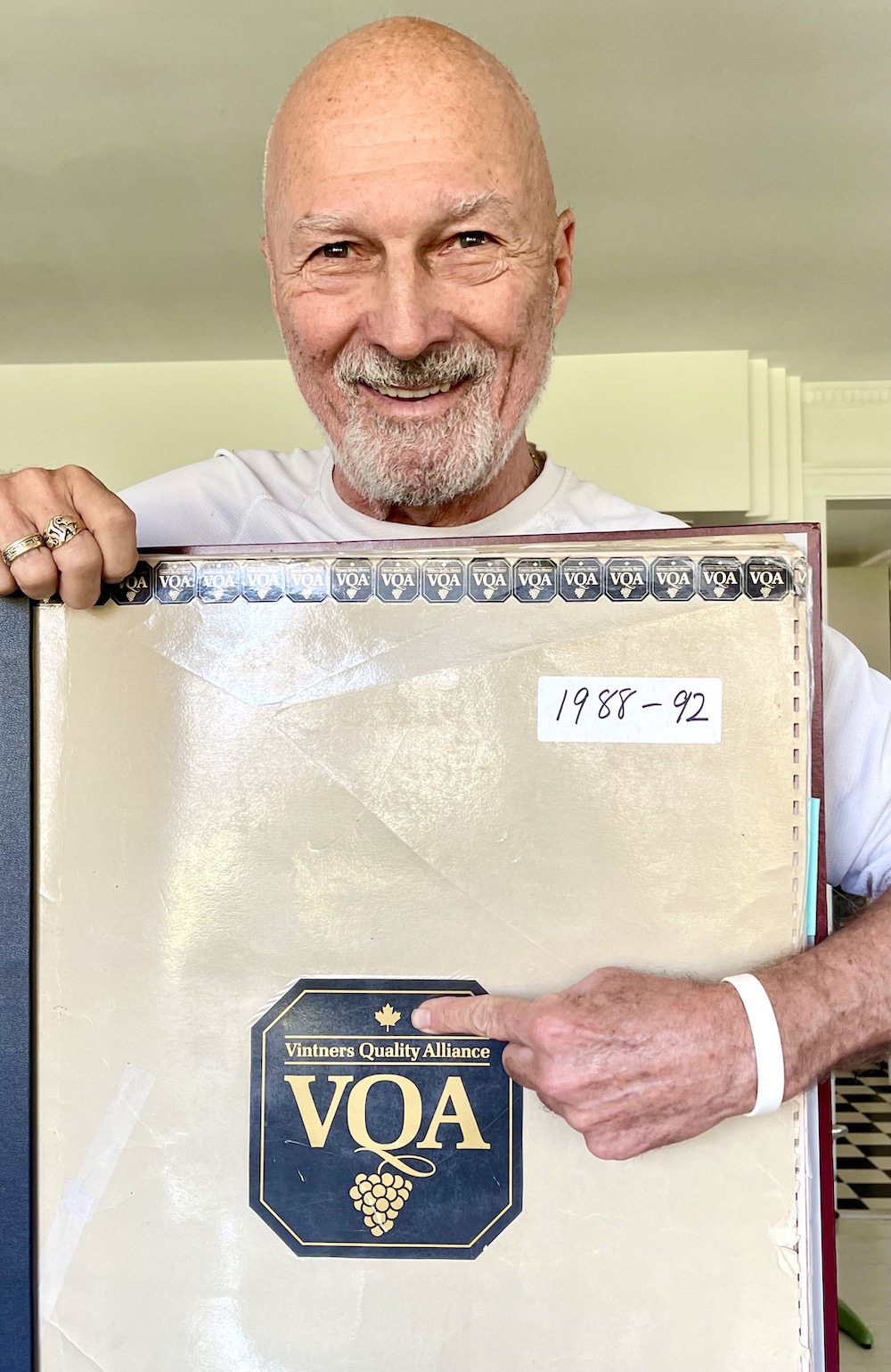
They manufactured wines that made their companies — Andres, Barnes, Brights, Chateau-Gai, Jordan and Ste. Michelle Cellars, London Winery and Turner Wines — millions of dollars but did little to convince consumers that quality wines could be made in Canada.
Ziraldo, Kaiser and a few other wineries, including Chateau des Charmes and Cave Spring Vineyard — wanted to flip the script and make classic European styled wines from noble, vinifera grapes, a daunting task that needed many moving parts to pull it off. They were up for the fight, buoyed by three significant events, each occurring around the pivotal year of 1988 — free trade with the U.S., an extensive grapevine pull-out and replacement program, and the groundwork that led to the Vintners Quality Alliance (VQA) standard in Ontario.
The signing of the Free Trade Agreement in 1988, together with a ruling under the General Agreement on Tariffs and Trade (GATT), meant Canada had to abandon the protection it offered its wine industry. While many of the big producers of the day felt threatened, a few new players responded by reaffirming their belief in their capacity to produce premium wines and redoubled their efforts to make it come to fruition.
To adjust to new trade rules and to better ensure competitive wines in the marketplace, Ontario and British Columbia growers, with the support of the federal and provincial governments, undertook a significant program to replace native grape varieties with vinifera. New vineyards were planted with Chardonnay, Riesling, Sauvignon Blanc, Pinot Gris, Gewurztraminer, Pinot Noir, Cabernet Sauvignon, Merlot, Cabernet Franc, and others.
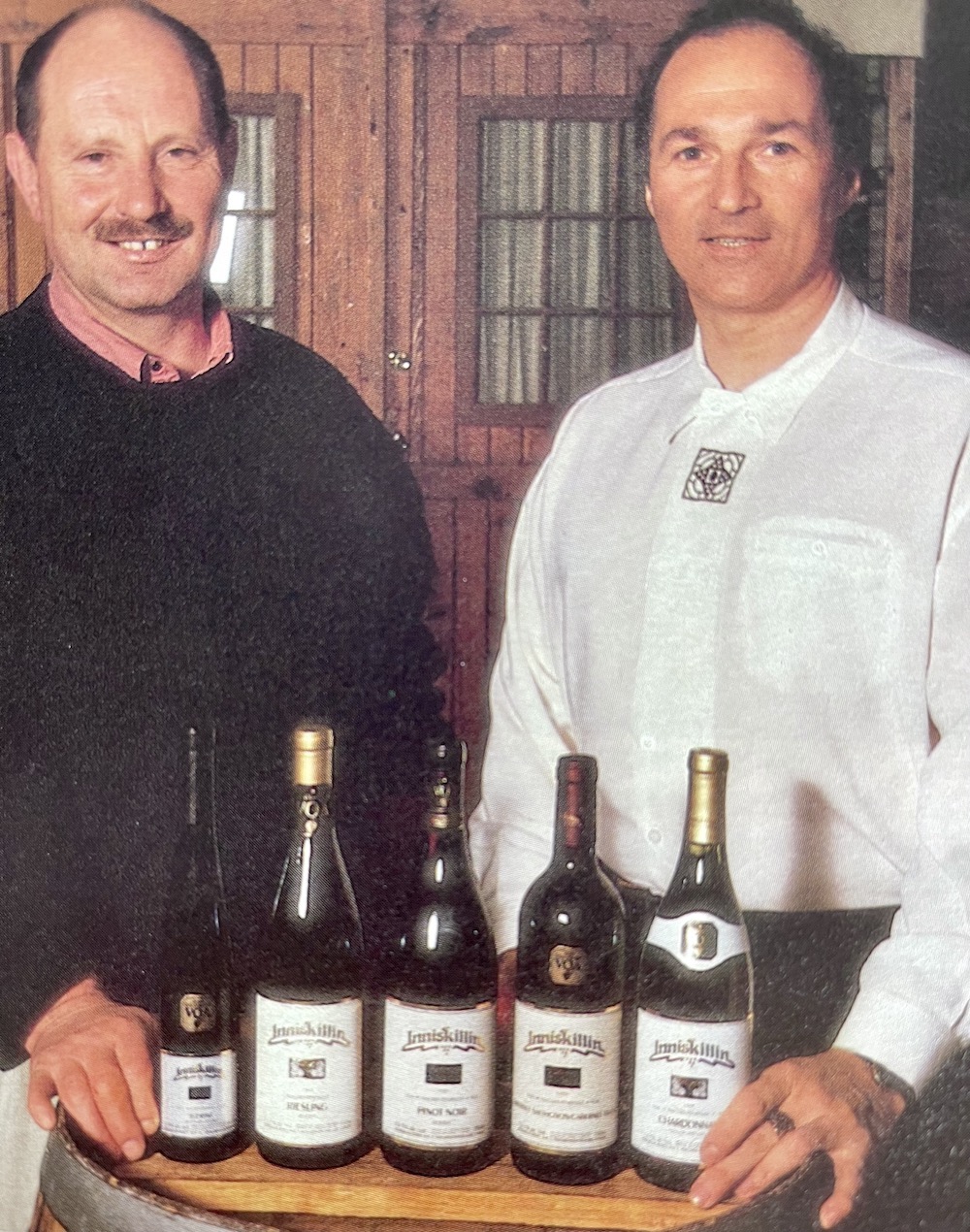
When VQA was finally launched has a voluntary organization in Ontario, following six years of initiatives by a collection of leaders in Ontario’s wine industry, led by Ziraldo (the first chair, from 1988-1995), Paul Bosc Sr. (Chateau des Charmes), Len Penacchetti (Cave Spring), Walter Smarantz (Pelee Island Winery), Jim Berry (Brights Wines), and Jim Patience of London Winery, a set of standards were agreed on with the goal of elevating the quality of Canadian wines, and providing quality assurances to the consumer at home and abroad. Peter Gamble was later hired as the first executive director of VQA (Ontario). Meanwhile, Harry McWatters was watching closely from British Columbia and was the driving force behind establishing BCVQA, which had similar criteria to the Ontario standards, but not exactly.
It wasn’t until June 29, 2000, that the Vintners Quality Alliance Act, 1999 was proclaimed by the Robert W. Runciman, then Minister of Consumer and Commercial Relations.
What many people do not know, and what gained little attention in 1988, was the fact that VQA was never envisioned as a provincial authority for wine quality and authenticity. Ziraldo and the initial working group fought hard to make it a federal authority, much like France’s AOC (Appellation d’Origine Contrôlée), to be the over-arching authority with sub-appellations in Ontario, B.C., Nova Scotia, and Quebec — the main wine regions in a Canada at the time. Never has that fact been more important than it is right now as wine regions from B.C. to Nova Scotia continue to deal with increasingly worsening, unpredictable weather that is impacting grape yields in all appellations, such as the winter of 2023 that has left B.C. wineries reeling with a nearly 100% loss of grape crop.
‘If I don’t do this, who is going to do it?’
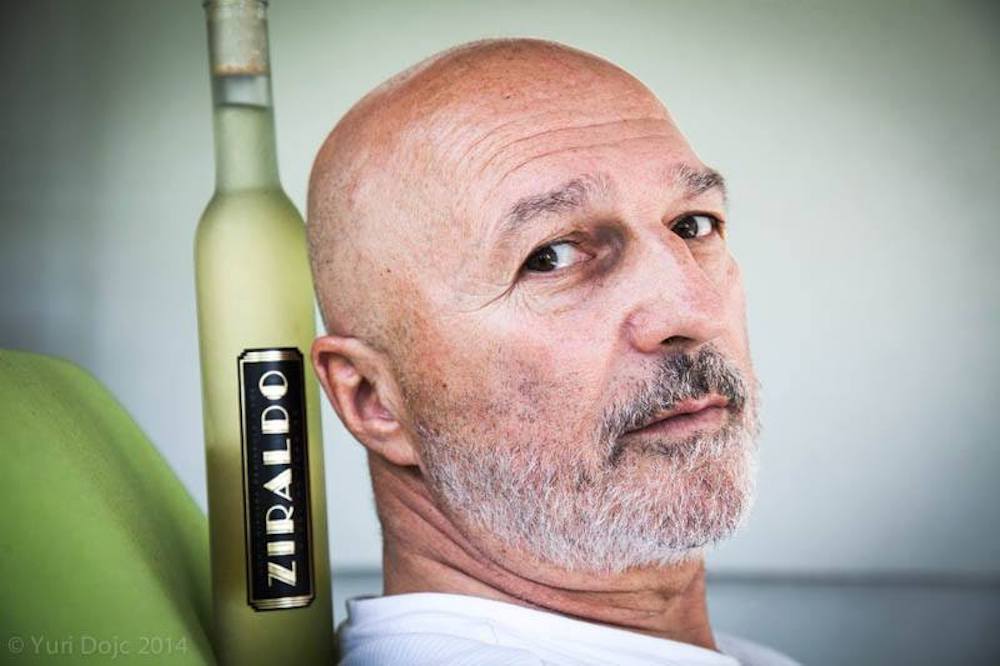
Sitting in the art deco adorned living room at Ziraldo’s estate on the Niagara Parkway, which butts up against the vineyard at the winery he once owned with his partner Kaiser, he’s in a feisty mood on this day and ready for what might be the next chapter of moving the Canadian wine industry forward. Ziraldo wants to bring back the notion of a VQA Canada authority out of concern for what is happening right now in B.C. and what could — and has — very well occur in Ontario, Nova Scotia, or Quebec with one bad winter, one widespread attack of red blotch or leaf roll disease, or anything else that looms large over the industry.
“If I don’t do this, who is going to do it,” he tells me with some conviction. He draws a rudimentary chart of what he originally wanted while working for six years on a VQA model. It had VQA Canada at the top of the pyramid with Ontario, B.C., Nova Scotia, and Quebec below in the hierarchy. His goal and that of the other members of the original committee working on the VQA plan, was always to eradicate the serious winemaking regions in Canada of labrusca grapes and force them by law to plant and promote the vinifera varieties to produce wines that could be sold to the EU, U.S. and other jurisdictions that had their own set of rules for quality and authenticity.
“It quickly become a political nightmare,” he tells me. The Ontario government, which owned and still owns the Liquor Control Board of Ontario monopoly, was embroiled in fast-moving free trade legislation and negotiations were moving fast and furious with trade-offs every step of the way. When the dust settled, the Ontario government insisted on legislating Ontario VQA, taking control of the authority away from the federal government. That ended the notion of a national authority, and it has never been broached again since 1988 — until now. As mentioned, B.C. moved quickly with their own provincial authority and Quebec and Nova Scotia have not yet shown signs of wanting their own set of standards, national or otherwise, likely due to restrictions on hybrid grapes that they rely on in their more hostile climates.
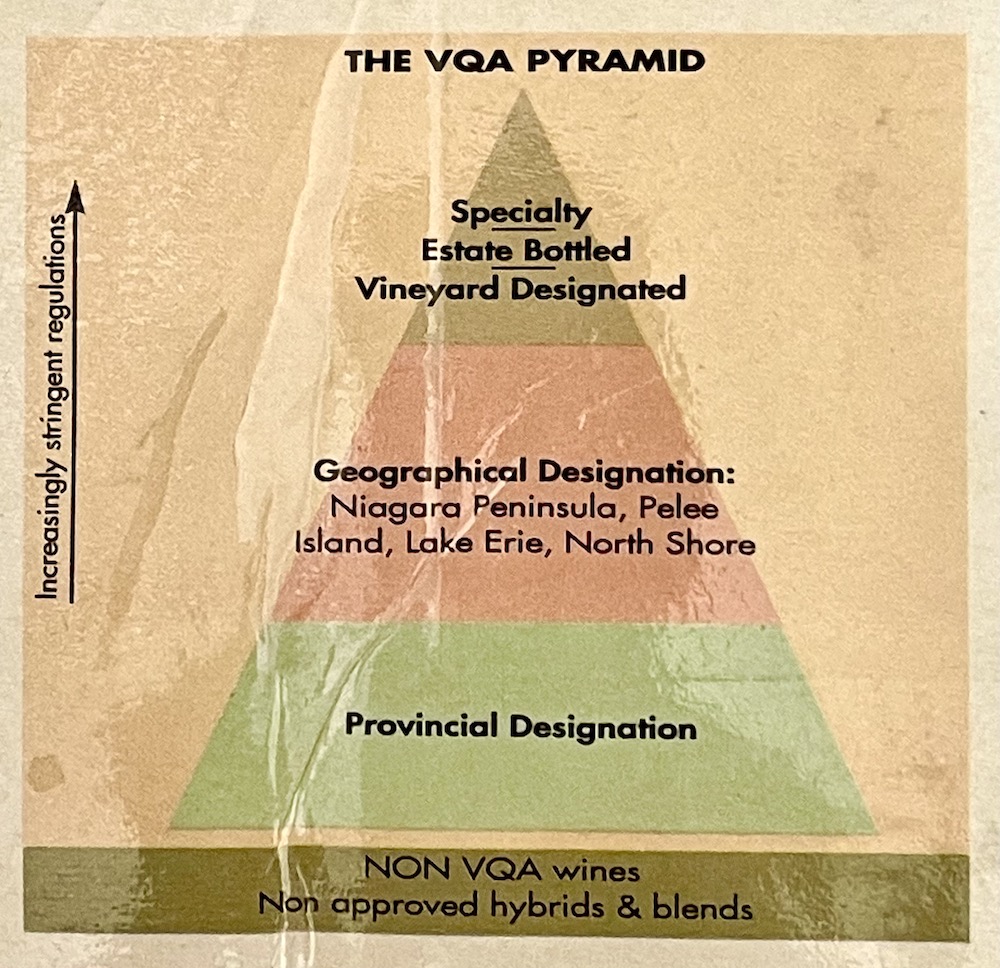
Under the original VQA Canada pyramid, the top tier represented “specialty, estate bottled, and vineyard designated wines.” The second tier was “geographical designation,” as in Niagara, Pelee Island and Lake Erie North Shore. The third tier was “provincial designation,” and finally “non-VQA wines” as in non-approved hybrids and blends.” Under VQA rules in the beginning, the only hybrid that was approved was Vidal, mainly because of icewine.
Ziraldo says the back-to-back cold episodes in B.C. is “an opportunity to get VQA Canada back on the table; it’s an opportunity to get VQA across the country.”
The idea for VQA Canada being resurrected stems from a meeting in February between concerned Niagara grape growers, Ontario Grape Growers’ chief executive Debbie Zimmerman, and Ziraldo at his home while he was convalescing following a freak accident a month prior. While the topic of helping B.C. wineries recover from the loss vines this harvest was foremost on the minds of growers at the meeting, Ziraldo had a higher purpose and floated the VQA Canada idea.
“It will help get (Canadian wines) into the European market,” Ziraldo told the Lake Report. “They follow the same rules where hybrids are not allowed.” For instance, he said, there are wines labelled as Ontario wine that utilize upwards of 75% imported juice from grapes. “Most people don’t know that.”
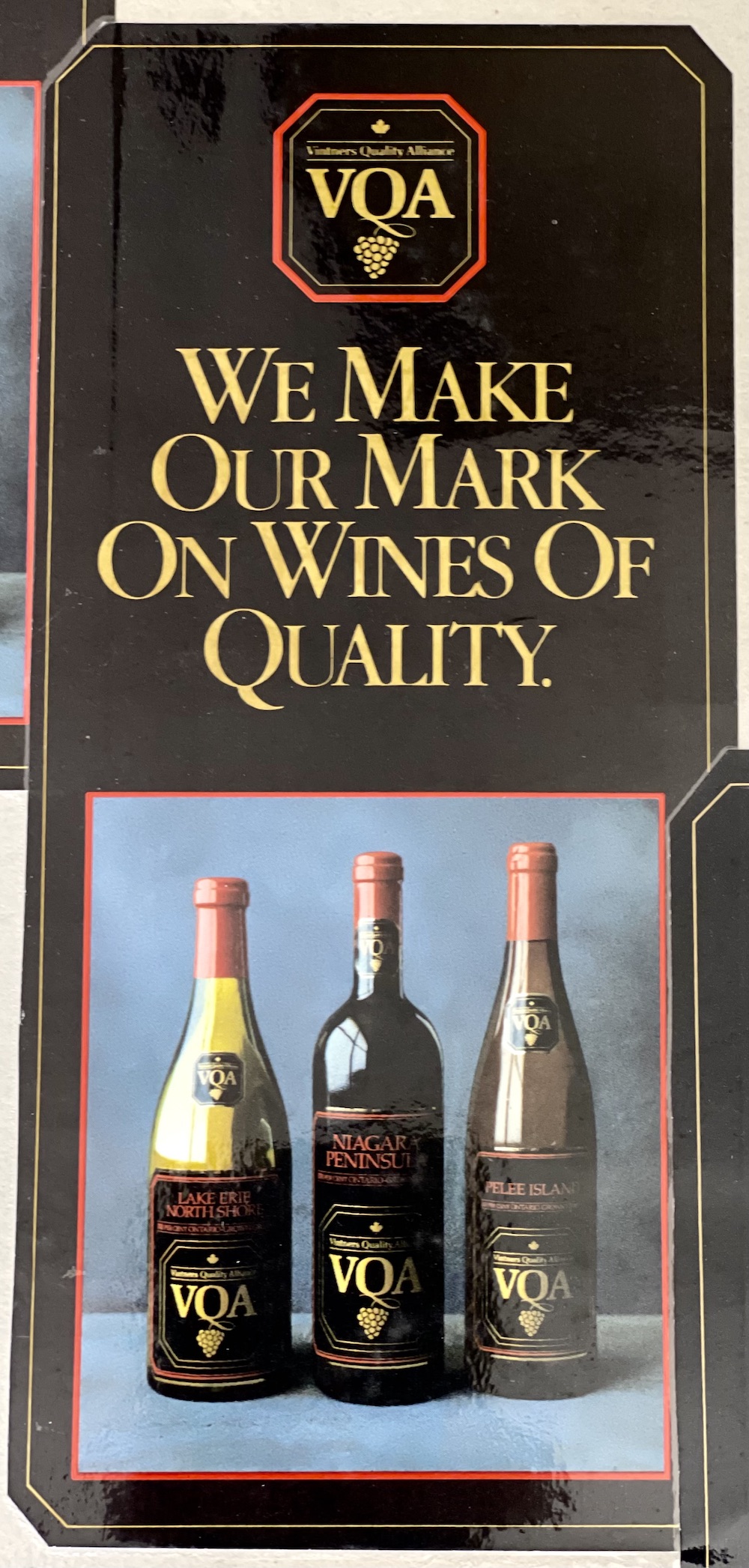
Zimmerman, meanwhile, told the Lake Report she fully supports such a change, saying that it would mean growers across the country could help each other out when disasters such as crop failures happen.
Highlighting the current failure of winery crops in B.C. caused by a mid-January cold snap, she said having national standards means Ontario growers could supply grapes or pressed grapes made from Ontario grapes to winemakers in B.C. and the end product would still be classified as a VQA wine.
Zimmerman said helping B.C. recover from its short crop is not a one-way street. She pointed to crops in 2003 and 2005 that were negatively affected by extreme weather across Canada and particularly in Ontario. In 2005 the crop was just 45,802 metric tonnes, Statistics Canada said in a report at that time. That was down from 70,872 tonnes just three years earlier in 2002 and what was then a record high. It happened again in 2022, Zimmerman said, when “complete blocks” of that year’s harvest were also lost. Statistics from the Wine Growers Ontario indicate that the 2022 crop was 46,056 tonnes in Ontario alone, valued at $62.4 million.
With a VQA Canada designation, grapes from B.C. coming east would help wineries better weather the short crops and at the very least allow Ontario wineries to have a VQA emblem on the label.
‘No more thoughts and prayers, we need action’
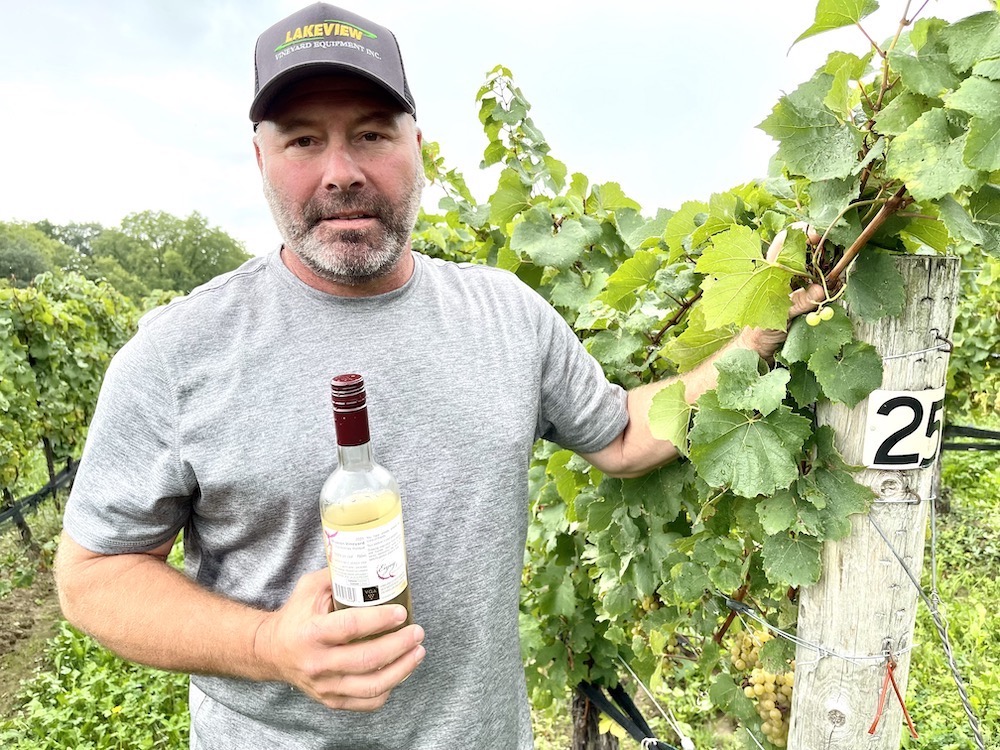
Ziraldo and Zimmerman are not the only ones talking about VQA Canada. Brian Schmidt (above), past chair (as of last Friday) of the Ontario Wine Appellation Authority (the regulatory arm of VQA Ontario) and winemaker at Vineland Estates Winery, has been discussing the issue in board meetings since they first learned of the catastrophe in B.C. this past January.
“Yes, we are in support of anything that moves Canadian wines forward,” he told Wines in Niagara. But he stresses, any plan has to respect the authority of BCVQA and VQAO. “We can’t abandon our own principals.”
Schmidt, who was chair for 12 years, sees it a bit differently than Ziraldo. He is in favour of a VQA Canada authority being run by each province and each future region who wants to adopt it, not a federally run entity, which he says would take several years to implement and has no guarantee of success. In the hands of existing bodies in the provinces, things can move fairly quickly, he said, with a set of standards that would include up to five “basic core principals — whatever they are” to follow and achieve VQA Canada status.
Schmidt and Ziraldo both pointed out that Dan Paszkowski, president and CEO of the Wine Growers of Canada (now called the Canadian Vintners Association), holds the trademark for VQA Canada with all the regulatory details drawn up by Ziraldo and the early authors of the VQA idea. Schmidt understands that a lot of wineries in B.C. “don’t want to use Ontario grapes” for whatever reason. He gets that, but at the same time a “pan-Canadian solution is a more palatable option that is predicated on national pride.”
And there are financial incentives to think of. Schmidt argues that the 6.1% excise exemption is at stake, not just in the short term for B.C. if they elect to import U.S. grapes, but for all wineries down the road. In B.C., wineries, while waiting for the provincial government to weigh on how they are going to handle the crisis, can change their licence from farm gate to commercial and essentially create a portfolio of wines under the International Domestic Blend model, opening the door to perhaps years of transitioning back to VQA wines. Today it could be Washington grapes, tomorrow it could be cheap grapes from California or beyond.
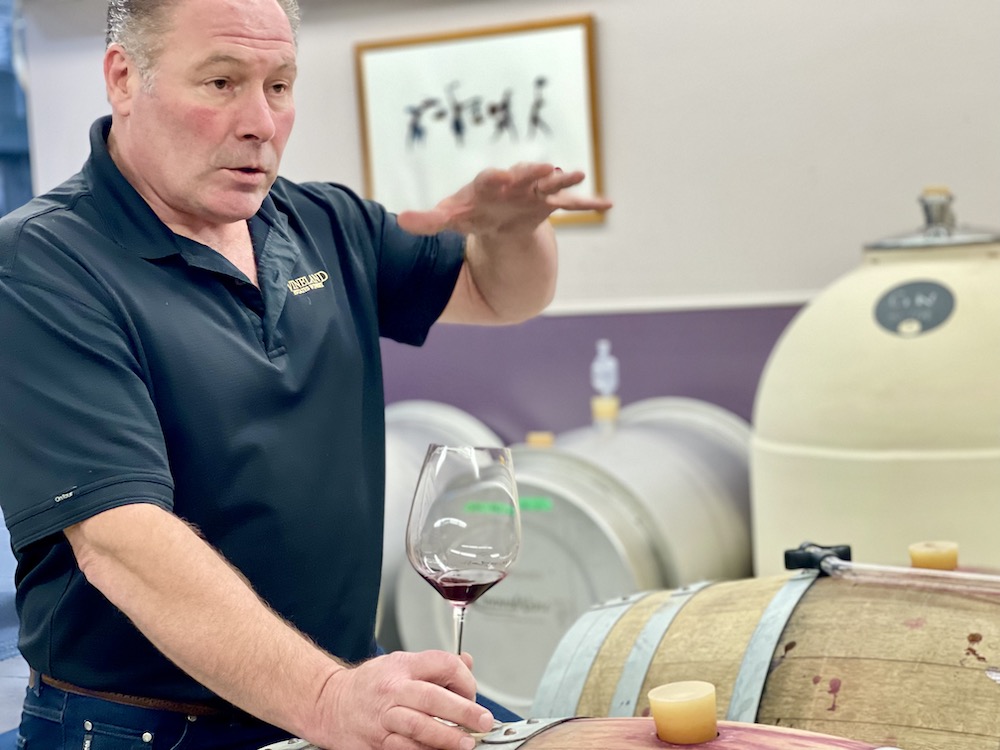
Schmidt favours a Canadian solution that involves VQA. “Every other major wine region has a national codified system,” he said. “We’ve matured in Canada, there’s a new current way of thinking. If we could find a way to do this, we think we could make it happen in a year to a year and a half. But we have to do the work now, no more thoughts and prayers, we need action.”
In the meantime, some wineries in Niagara, including Vineland Estates, are already working with B.C. wineries to get grapes and/or grape juice to them. Schmidt is working with two or three wineries, including Mt Boucherie in West Kelowna, and investigating what it would cost to get whole grapes or pressed grapes to the Okanagan. The first option would be to export pressed grapes that’s cold fermented, settled and sent in a chilled environment to B.C. The other option is sending grapes, 12-15 tonnes per truck, keeping them chilled over the two days it would take two drivers to get there. “It’s a bit more involved getting fresh grapes there,” said Schmidt, but the winemakers would be involved in the process from the beginning. They would fly to Niagara, work with the winery during harvest, and have a say in the grapes that they want to purchase and make the wines in the style that conforms to the B.C. winery’s style. He estimates the cost of, say, a metric tonne of Niagara Chardonnay at 22 brix (sugar levels) would rise to about $3,500 a metric tonne by the time it arrived in the Okanagan, depending on factors such sugar levels, hand-harvested or machine harvested grapes and other factors.
One of the wineries working with Schmidt and Vineland Estate is Mt Boucherie Estate Winery. Winemaker Jeff Hundertmark jumped at the chance to work with a Niagara winery to fill some of the holes left by the catastrophic loss of vines over the 2023 winter and 2024 vintage coming up. Hundertmark has deep ties to Niagara as a respected winemaker at both Stoney Ridge and Marynissen and understands both regions intimately. He is adamant that a Canadian solution is the best way to go, at least for his winery.
Wines in Niagara reached out to Hundertmark for his thoughts on the politics of bringing grapes from the U.S. versus Ontario. This is his passionate and remarkable response, in his own words:
‘I choose Canada. I always have, and always will’
By Jeff Hundertmark, director of winemaking at Mt Boucherie Estate Winery in West Kelowna
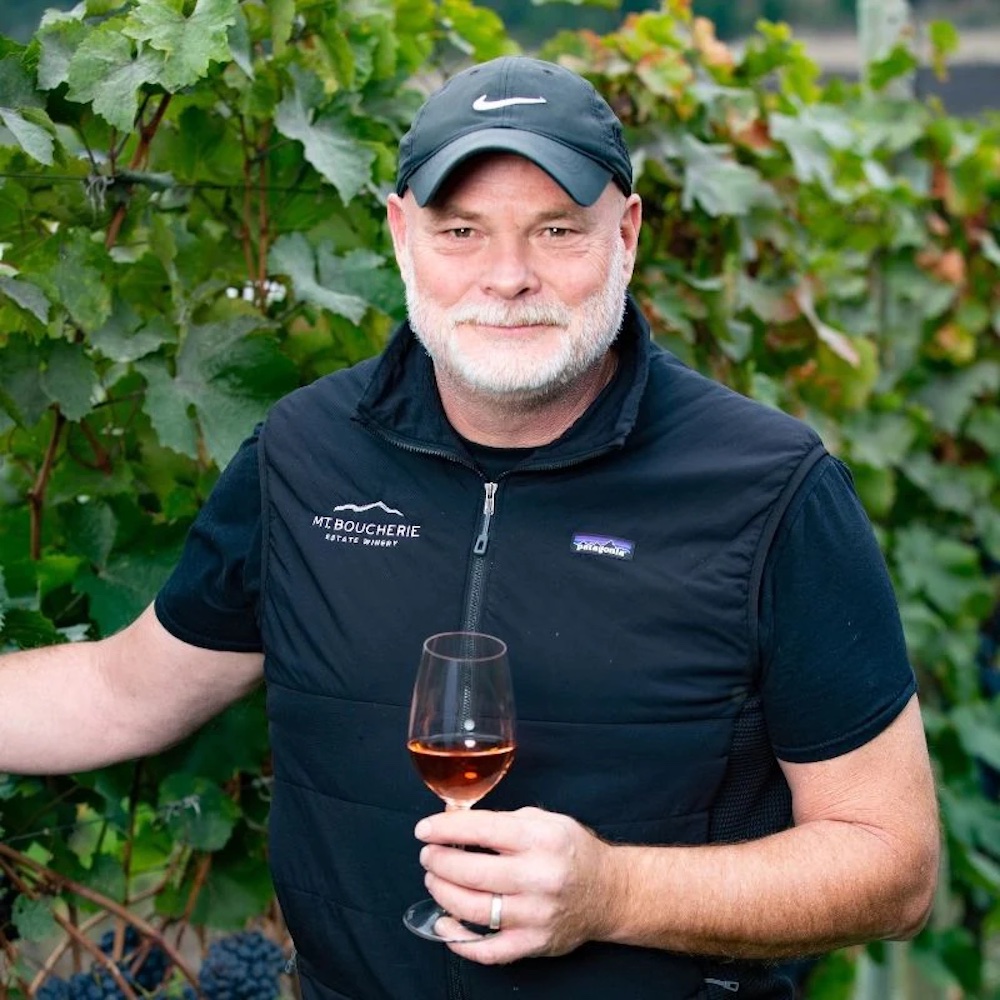
B.C. has a very conflicted view on using grapes from outside the B.C. borders. Some of it based in PRIDE (rightfully so, we make some damn fine wines) and some of it based on FEAR (consumers won’t understand and therefore our industry will suffer) and some of it based on IGNORANCE (Ontario’s grapes are inferior, we don’t get many Ontario wines out here and the opinion is because they aren’t very good), and some of it is based on SOCIAL CONSCIENCE (Washington is close by so the impact to the environment for shipping will be less) … note, this also falls under hypocrisy.
I have lived in and made wine in both regions in Canada, and I can tell you, if we think our Rieslings, Chardonnays and Pinot Noirs are heads and shoulders above Niagara, we need to taste more Niagara. There are some incredible examples of those wines, we just don’t get them here.
There are also some bad wines, but please feel free to look in the mirror B.C. We also have some weak wines here. Washington state is also not immune to some fairly weak wines. To me, terroir is not just where the raw product is grown, but it’s also the handling of the raw product; it’s the passion, artistry, and imagination of the winemaker.
Thomas Bachelder makes wine from grapes sourced all over, Ann Sperling makes wines from all over, hell, Mouton Rothschild makes wines from all over the world. Their commitment to regional wines has been celebrated by their customers. They don’t just make wines from their home province or country, they are global, and successful as a result.
The terroir question is one that we celebrate and highlight all the time here in B.C. At Mt Boucherie, we grow grapes in West Kelowna where it is slightly cooler, we grow grapes in the Similkameen and Golden Mile, where it is hot and dry, and we grow at elevation in OK Falls where the growing conditions are sublime. I make wines from vineyards we contract in Osoyoos, the Black Sage Bench, and Naramata. We CELEBRATE that.
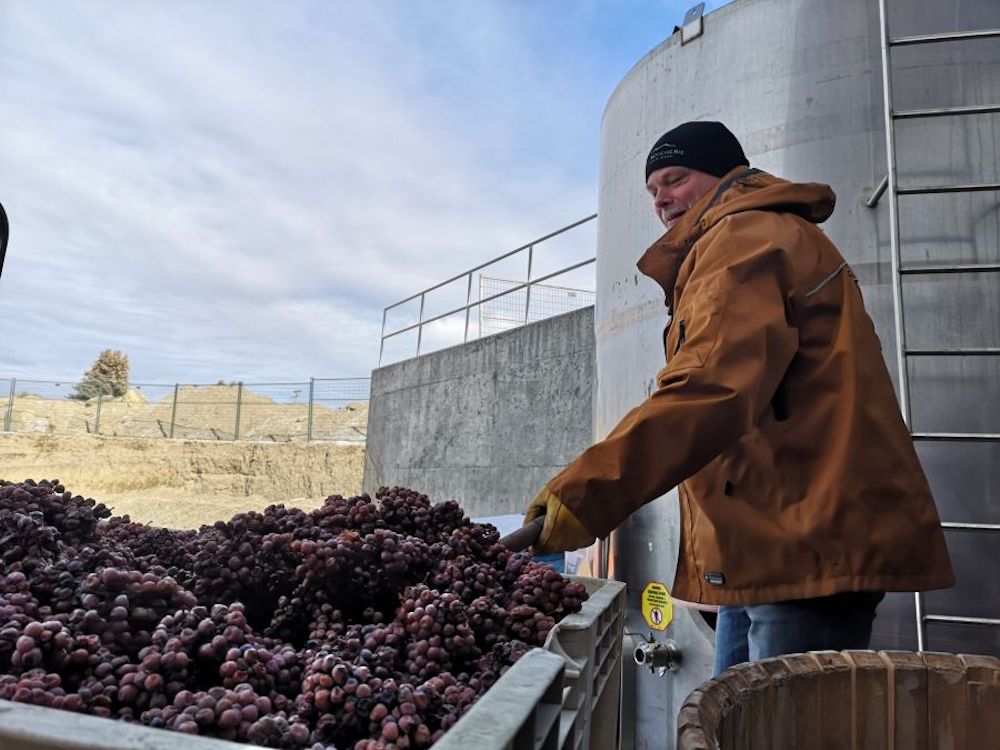
Mt Boucherie will be making some very tough decisions in the coming months, but I will tell you, it will not be whether we just sit on our hands and hope that we can ride out the next two years with no wine to sell; it will be a choice of which varieties and how many tonnes of grapes can we buy. Our government needs to make some big rule changes, and fast!
Our initial plan is to partner up with a grower or two in Niagara, and I will head there myself to supervise and add my skills to produce a Mt Boucherie “VQA Canada” series of wines. We are making this decision because it is right for our brand, our customer and for our business survival.
I am not suggesting that those who choose to buy grapes from Washington or Oregon are making a wrong decision; they are making the best decision for their brand, their customer and for their company.
For my two cents, I Choose Canada. I always have, and always will.
The view from the west
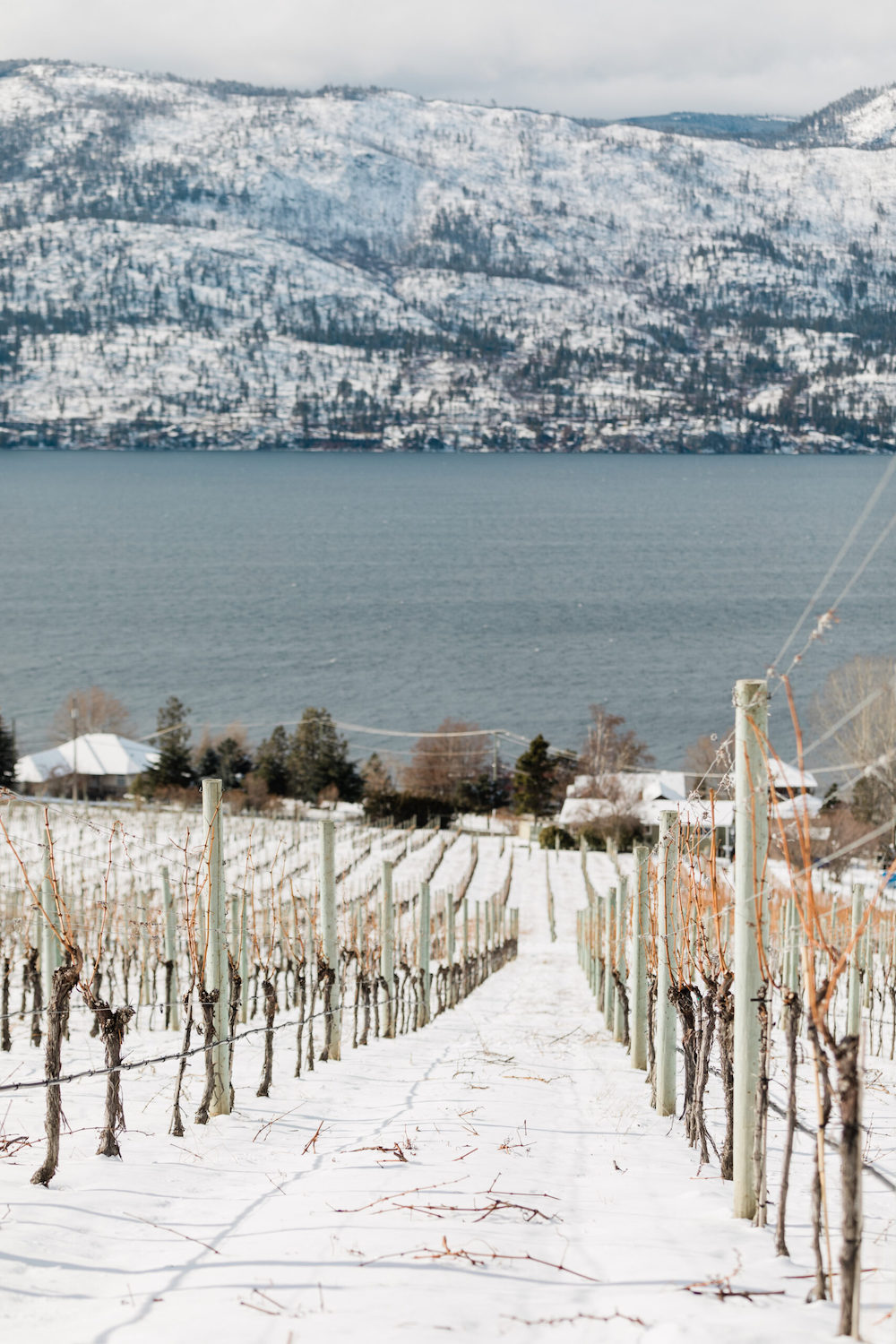
While emotions are running high in B.C. about next steps and how to deal with the projected short crop in the Okanagan Valley, which could amount to nearly all grapes in impacted vineyards, many are making their feelings known about importing grapes from Ontario.
The South Okanagan Wine Network has been following the issues closely, and commenters don’t hold anything back, with a mostly negative view for using grapes and/or juice from Ontario.
Washington Winegrowers, a non-profit trade association, is pushing hard for the exporting of its grapes, which has a 40% over supply due to the state’s largest producer, Chateau Ste. Michelle, cutting back on supply. In a story by Sean P. Sullivan in the Northwest Wine Report, quoted Colleen Frei, executive director of Washington Winegrowers, as saying “our wine growers currently have grape supply, and B.C. has a demand because of the recent freeze, so we’re trying to do some matchmaking which might benefit everyone.”
The association has put together a complete guide for exporting whole wine grapes, crushed grapes, and pressed wine grapes into Canada. It also includes a checklist for U.S., Washington, and Canadian requirements as well as a resource list. “B.C. wineries are going to need wine grapes from somewhere,” Frei told Sullivan. “To get them from somewhere that’s the closest seems to be ideal, certainly from a global environmental footprint.”
The document has been co-ordinated by a long list of Washington and U.S. government agencies, including the Washington State Department of Agriculture, United States Department of Agriculture, Animal and Plant Health Inspection Service, Agricultural Marketing Service, and others. The Washington State Wine Commission, the state agency charged with promoting Washington wine, has also been involved.
On paper, there are clear synergies between Washington and British Columbia, the report states. Washington has an excess of grape vines planted. This is in large part due to Ste. Michelle Wine Estates, the largest winery in the Pacific Northwest, telling its Washington growers last summer that the company was decreasing its fruit input by 40%. As a result, tens of thousands of tons of grapes went unpicked in 2023. In contrast, British Columbia has a grape need.
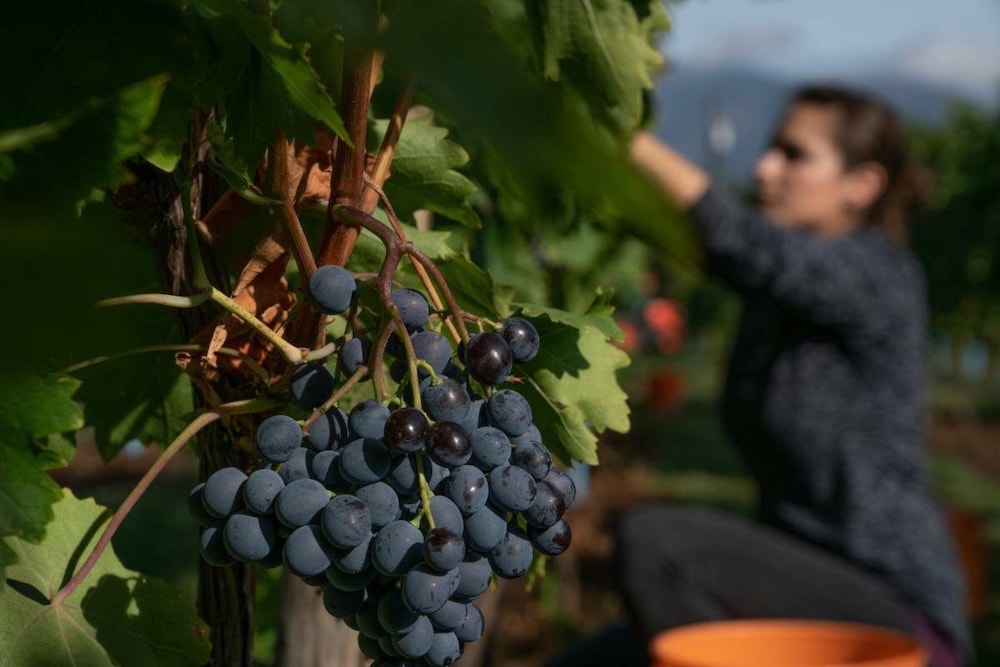
The two areas also share a border and are similar in their northern latitude. British Columbia’s most planted varieties include Merlot, Pinot Noir, Pinot Gris, Chardonnay, Cabernet Sauvignon, Cabernet Franc, Riesling, Gewürztraminer, Syrah, and Sauvignon Blanc. All of those varieties have abundant plantings in Washington, Sullivan wrote.
The report also pointed to the problems with importing grapes from Washington, not the least of which is the fact that the grapes available were farmed to high tonnage and cannot necessarily be immediately converted over to wineries for high quality wines.
British Columbia regulatory requirements are also at issue, the report said. Among them, land-based wineries — wineries that grow some of their own fruit — must make a certain percentage of wine from those plantings. Using grapes from an area outside British Columbia would require waiving those regulations.
“What we’re asking for is special dispensation to be able to bring in fruit from, it could be Ontario, it could be Washington, it could be Oregon,” David Paterson, GM and winemaker at Tantalus Vineyards in Kelowna, told Northwest Wine Report earlier this month.
There are other considerations for British Columbia, such as how the wines might be labeled and to whom they might, or might not, be sold to. “It all has to be 100% transparent,” Nikki Callaway, winemaker at O’Rourke Family Estate in Lake Country, told Sullivan. “We probably can’t export the wines. It probably can’t be sold elsewhere. “Some B.C. wineries are interested in importing grapes from Ontario. Others are less enthusiastic about the possibility. I will not buy grapes in Ontario,” Callaway said. “I don’t see the benefit of travelling four days across the country just because they’re Canadian grapes.” She also noted that Washington and Oregon share similar terroir to the Okanagan Valley.
‘VQA Canada would be a
big stepping stone’

Wines in Niagara reached out to Al Hudec (above), a prominent legal advisor to the B.C. wine industry, advising on purchase and sale transactions and regulatory matters, as well as writing and commenting on the issues of the day facing B.C. wineries.
Hudec said that logistically, Washington appears to be a more viable option for B.C. wineries. “There is a bit of bias about Niagara grapes,” he said, while others “believe Canadians should stick together. There are passionate people who want a national solution.”
A lot of the decisions the wine industry will make in B.C. depend on what the province decides to do with financial assistance, relief from markups and rebates.
“In my mind, the big issues are whether the government would consider a tax remission on an interim emergency basis to allow wineries to replace a portion of 100% B.C. product with non- B.C. product and whether consumers would be interested in purchasing,” Hudec said on the South Okanagan Facebook forum. And it would seem logical that the B.C. government would favour a Canadian solution for a Canadian problem, rather than opening up the border to U.S. wines and risk high markups and setting yourself up to shelving problems listing wines through the liquor board. “If we want to maintain our presence, we can do that with Canadian wines,” Hudec said.
Hudec sees potential for a VQA Canada solution. “Integration for our industry between provinces would be great for everyone,” he said. “VQA Canada would be a big stepping stone toward that.”







I can not imagine that it makes sense economically, or from an environmental perspective, to ship grapes from Ontario to B.C. (or vice versa). I also do not think it advisable to import grapes from the U.S. despite its proximity and any climatic similarities which may exist, due to the likelihood that it would result in the substitution of grapes or juice from increasingly distant locales.
This would necessitate that the Canadian industry remain relatively small on a global scale. But shouldn’t we be placing authenticity in its rightful place in the VQA system?
There is no doubt that Ontario grapes are one option for BC. I have always supported Ontario wineries as well as BC wineries and if this idea works for some BC wineries then that is good. For many other wineries, though, it makes no sense to bring grapes from across the country, thousands of kilometers when Washington state is so close and has extra grapes for sale for the foreseeable future. If that is what works for those wineries then that is also the solution. There are also some wineries that will be able to ride out this storm with their inventories and allocations until new production comes on line. That is what is right for those wineries. There definitely is no one size fits all solution here. There are two parts about this article that I really take offense with. First, to say that brining in grapes from the states might open the door to cheap California grapes–well I can tell you that is a very offensive statement. Indeed California has cheap grapes but so does Ontario and at the end of the day, wineries will choose where and from what growers and at what quality level makes sense for them. The bigger issue I have with this article is this…this is not the time to put in place a National Canadian Wine Standard. It has been tried 2 times before and in much easier times, with fewer voices at the table and with no crisis looming it still wasn’t achievable. BC wineries have been through WAY more in the last year than any wine industry I am aware of. It is in crisis mode right now. No only have they dealt with what other areas have had to deal with such as COVID but constant wildfire disruptions to travel and wine quality (smoke taint), then two years of freeze with vine death and loss of crop, then Alberta making wineries choose between being on the shelf versus whether they should honour their club members–all over laws still on the books going back 100 years, then their “partner” SaveOn blackmailing their own suppliers with putting International blended wines on shelves that were always designated to be 100% BC. And most of these things have happened in the past 2 months. Do we really need to start a new conversation right now about starting a Canadian wine standard? Really? Is this fair Ontario? Even if it is desirable ,and it just might be, why does it have to start now with a push for discussions? I think it is callus and tone deaf for Ontario and BC leaders (some at the WGBC) to recommend a new round of talks about Canadian wine standards when the BC industry is trying to sort through all it has been through in the last few months. I say LAY OFF! Let BC figure out how the dust is settling right now and let them figure out what makes sense for their own businesses. When that’s over, and times are calmer, then let’s talk about what makes sense for a national wine standard. Let make sure that any benefits given to Ontario grapes on the shelves of BC are reciprocated on the Ontario shelves of the LCBO. I’m sorry if I don’t believe a word of this article. Ontario can sell direct to consumers in my province but our wineries still cannot do the same in Ontario because they have not yet reciprocated. We have been waiting 13 years for that. How about Ontario rectifies the Free My Grapes imbalance before asking BC for more considerations? How about Ontario just quiets down a bit and lets BC wineries figure out how to make sense of all that has happened before it is asked to see how the goal posts are going to change again? How about that?